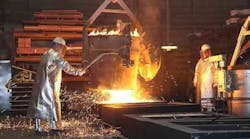A new year is speeding up on the metalcasting industry, and the men and women who do the planning and decisionmaking for foundries and diecasting operations have their opportunities to extend the progress they’ve made during 2014, or to launch a fresh start. It may be only a point in time, but it’s essential to the way we live, and work, to be able to pause, assess the progress, and reevaluate the future prospects.
That is reason that we conduct the annual FM&T Business Outlook survey. Each year, during September and October, FM&T surveys metalcasters to measure the outlook of men and women responsible for North America’s foundries and diecasting plants. We seek to identify the problems they face in their businesses and the economy, to learn what plans they're making for the coming business cycle, and to understand better they're expectations for the year ahead.
We surveyed readers by email over a period of six weeks, with a detailed study that focuses on the metalcasting business, its risks and prospects, and the internal and external factors shaping its progress. Their perspective is valuable not only because of their insights and advantages, but because they occupy positions that are critical (perhaps essential) to the prospects of so many other elements of the global industrial economy.
Let’s start with the big picture: currently, the broader industrial economy appears to be in very solid condition. The latest results from the Institute for Supply Management’s Purchasing Managers’ Index — a monthly survey of 400 purchasing managers that tracks production levels, volumes of new orders, rates of supplier deliveries, inventories, and employment levels — indicated that the industrial economy in which metalcasters operate continues a trajectory that has moved upward since early 2013.
More in detail, the new PMI study shows manufacturing industries continued to enjoy rising levels of new orders (i.e., demand), production volumes, employment, and raw material inventories. PMI offers a wider perspective of the manufacturing economy than the one our metalcasting survey respondents view, but it is informative of their operating conditions. It portrays the activity of businesses that are buying castings.
PMI measures recent activity. It is one vantage point for examining future conditions, but it’s not the only one. A contrary view of current manufacturing conditions may be found in the Census Bureau’s Advance Report on Durable Goods Manufacturing, which has posted two consecutive months of slower results. There are other unsettling industrial trends too (steel prices, metal service center deliveries, machine tool orders) that suggest manufacturers are uncertain about near-term demand.
Larry Korak, director of Industry & Strategy for Infor’s Industrial Manufacturing business (a developer of enterprise software platforms), accepted the challenge: “Although durable goods orders declined in the most recent two months, we anticipate growth of between 2% and 3% in 2015,” he said, citing a series of countervailing factors. These include a housing sector that has grown “gradually and steadily since 2012”; slow growth in manufacturing wages (“the amount of money companies can spend on infrastructure”); and continued availability of affordable natural gas, which reduces manufacturers’ operating and material costs (i.e., plastics and resins.)
Korak also sees positive signs for U.S. manufacturers’ position in the global economy. “The Trade Weighted Index is anticipated to rise slightly in the coming year,” he reported, “which indicates that the dollar is strengthening relative to the currencies of other major trading partners. When the value of the dollar increases, imports to the U.S. become less expensive while exports to other countries become more expensive. This slight change typically favors importers. However, consolidation and globalization within durable goods manufacturing should tend to offset this impact.”
He also pointed to a World Bank forecasts for slight reductions in world commodity prices throughout 2015, suggesting manufacturing customers will be able to extend their purchasing without concern for inflation.
The Infor strategist sees these factors as generally beneficial to durable goods manufacturers, regardless of their particular production programs. “We anticipate slight growth across all sectors,” Korak offered. “The largest concern we see is in the availability of skilled labor within rural areas, which is constraining growth. Small producers and fabricators are particularly at risk given their inability to compete for resources, (and) this trend is not sector specific.”
To gain that specific insight to metalcasting market trends, let us review the information available from more than 200 individuals active in the industry, surveyed in detail for this report. (Read part 2, Present Results, Future Prospects.)









